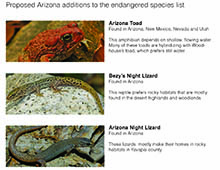Cronkite News has moved to a new home at cronkitenews.azpbs.org. Use this site to search archives from 2011 to May 2015. You can search the new site for current stories.
Environmental group seeks endangered status for four Arizona species
PHOENIX – A Tucson-based environmental group is petitioning the U.S. Fish and Wildlife Services to put seven amphibians and reptiles on the endangered species list, including four native to Arizona.
Citing declining populations, the Center for Biological Diversity filed a formal notice of intent to sue the U.S. Fish and Wildlife Service on Jan. 16.
The list includes the Arizona toad, which is also found in New Mexico, Nevada and Utah; the Arizona night lizard, found in rocky areas of Yavapai County; the Bezy’s night lizard, found mostly in desert highlands and woodlands; and the Yuman Desert fringe-toed lizard, found in southwestern Arizona.
The other species on the list are the Cascade Caverns salamander, native to Texas; the Rio Grande cooter, a turtle native to Texas and New Mexico; and the Reticulate collared lizard, native to Texas.
“They face unique threats,” said Collette Adkins Giese, a center biologist and lawyer. “One thing that is common is that their habitats are threatened.”
The center filed a petition in July 2012 for these animals, but Adkins Giese said the agency never looked into it. U.S. Fish and Wildlife Service has 90 days to look into the current petition.
Adding an animal to the endangered species list can take years.
“It is frustrating,” Adkins Giese said. “The longer we wait, the more difficult it is to save them.”
Adkins Giese said these animals face habitat loss from urbanization and are also harmed by climate change and pet collectors.
Gavin Shire, a U.S. Fish and Wildlife Service spokesman, said that data is analyzed before deciding if an animal can be added to the endangered species list. If an animal is especially at risk, an emergency petition can be filed.
The list doesn’t have a numerical threshold. There are more than 1,000 animals and plants that are endangered or threatened.
“Some would say the list isn’t long enough and some would say it’s too long,” he said. “But we think the list is right.”
There are more than 30 endangered plants and animals in Arizona.
Tom Jones, amphibians and reptiles program manager at the Arizona Game and Fish Department, said there is no indication that the amphibians and reptiles listed by the center have declining populations or face threats to their habitats. The agency hasn’t studied the populations, he added.
“In my opinion they are looking for species that have limited geographic ranges and are making assumptions,” Jones said.
The department is dedicated to conservation but tries to identify species in trouble based on observations before deciding to do costly field work, he said.
“It is difficult for us when are are forced to waste our time on species we have little information about,” Jones said.









